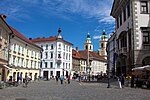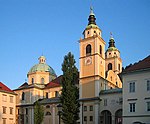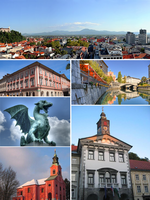Drava Banovina
1929 establishments in Yugoslavia1941 disestablishments in Yugoslavia20th century in SloveniaBanovinas of the Kingdom of YugoslaviaFormer states and territories in Slovenia ... and 4 more
Modern history of SloveniaPolitics of YugoslaviaStates and territories disestablished in 1941States and territories established in 1929

The Drava Banovina or Drava Banate (Slovene and Serbo-Croatian: Dravska banovina), was a province (banovina) of the Kingdom of Yugoslavia between 1929 and 1941. This province consisted of most of present-day Slovenia and was named for the Drava River. The capital city of the Drava Banovina was Ljubljana.
Excerpt from the Wikipedia article Drava Banovina (License: CC BY-SA 3.0, Authors, Images).Drava Banovina
Mestni trg, Ljubljana Trnovo
Geographical coordinates (GPS) Address Nearby Places Show on map
Geographical coordinates (GPS)
| Latitude | Longitude |
|---|---|
| N 46.049772222222 ° | E 14.506577777778 ° |
Address
Mestni trg
Mestni trg
Ljubljana, Trnovo
Slovenia
Open on Google Maps









